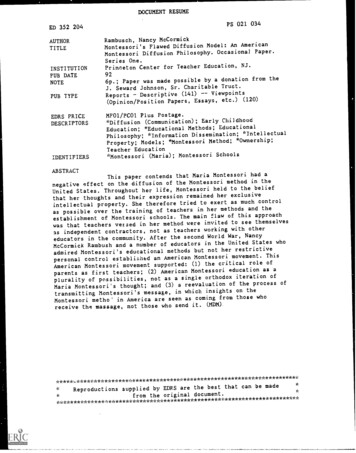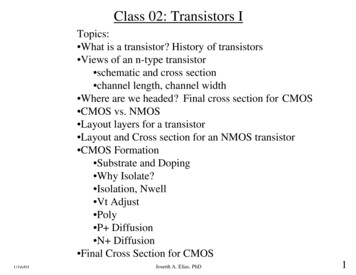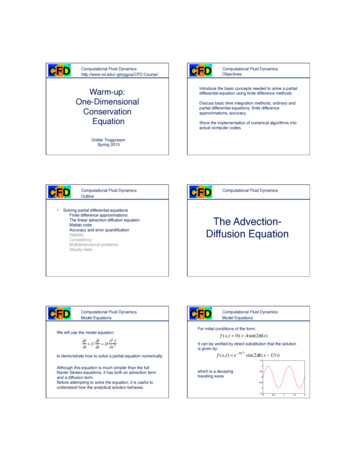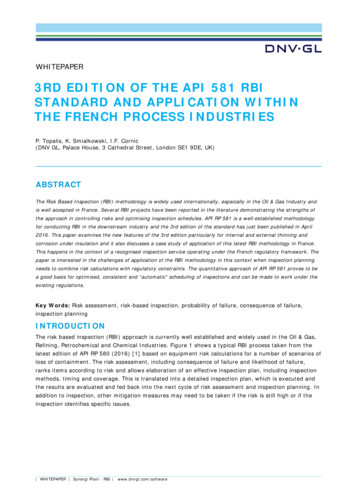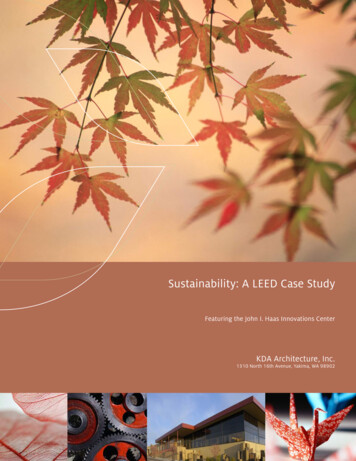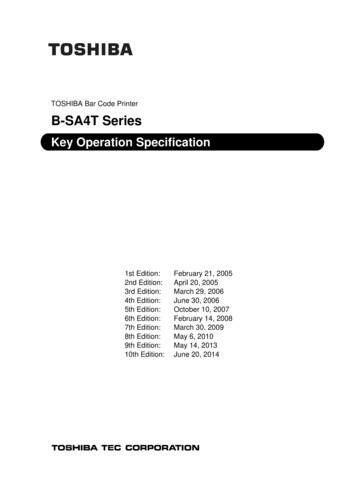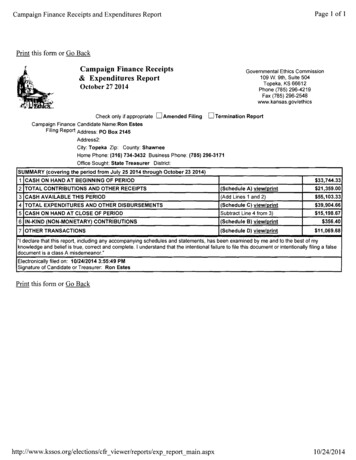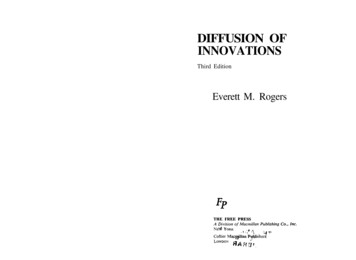
Transcription
DIFFUSION OFINNOVATIONSThird EditionEverett M. Rogers
Copyright 1962, 1971, 1983 by The Free PressA Division of Macmillan Publishing Co., Inc.ContentsAll rights reserved. No part of this book may be reproduced ortransmitted in any form or by any means, electronic or mechanical,including photocopying, recording, or by any information storageand retrieval system, without permission in writing from thePublisher.The Free PressA Division of Macmillan Publishing Co., Inc.866 Third Avenue, New York, N. Y. 10022List of Case IllustrationsPrefaceCollier Macmillan Canada, Inc.xiiiLibrary of Congress Catalog Card Number: 82-70998ELEMENTS OF DIFFUSION1printing numberWHAT IS DIFFUSION?56 7 8 9 10FOUR MAIN ELEMENTS IN THE DIFFUSIONOF INNOVATIONSPrinted in the United States of AmericaLibrary of Congress Cataloging in Publication DataRogers, Everett M.Diffusion of innovations.Chapter 1/.2.3.4.The InnovationCommunication ChannelsTimeA Social SystemSUMMARYRev. ed. of: Communication of innovations. 2nd ed.1971.Bibliography: p.Includes indexes.1. Diffusion of innovations. 2. Diffusion of innovations—Study and teaching—History. I. Title.HM101.R571983303.4'8482-70998ISBN 0-02-926650-5AACR2THE AMERICANCENTERLIBRARY1117202434Chapter 2 A HISTORY OF DIFFUSION RESEARCH . . . . 38THE BEGINNINGS OF DIFFUSION RESEARCHIN EUROPEGabriel Tardeand The Laws of ImitationThe British and German-Austrian DiffusionistsTHE RISE OF DIFFUSION RESEARCH TRADITIONS.The first edition by Everett M. Rogers was published as Diffusion of Innovations; the secondedition of this book, by Everett M. Rogers with F. Floyd Shoemaker, was published as Communication of Innovations: A Cross-Cultural Approach.10Paradigms and Invisible CollegesThe Anthropology Research TraditionEarly SociologyRural SociologyEducationPublic Health and Medical SociologyCommunicationMarketingGeographyGeneral Sociology4040414243465057626572747778V
ContentsviA TYPOLOGY OF DIFFUSION RESEARCH79SUMMARY85Chapter 3 CONTRIBUTIONS AND CRITICISMS OFDIFFUSION RESEARCH87THE CONTRIBUTIONS AND STATUS OFDIFFUSION RESEARCH TODAYCRITICISMS OF DIFFUSION RESEARCHThe Pro-Innovation Bias of Diffusion Research . . . .The Individual-Blame Bias in Diffusion ResearchThe Recall Problem in Diffusion ResearchThe Issue of Equality in the Diffusion of InnovationsGENERALIZING ABOUT DIFFUSION VIAMETA-RESEARCHRelating Theory and Research at the Middle RangeThe Oversimplification of Two-Concept Generalizations.The Reliability of Diffusion GeneralizationsSUMMARYChapter 4 THE GENERATION OF INNOVATIONS . . .THE INNOVATION-DEVELOPMENT PROCESS1.2.3.4.5.6.Recognizing a Problem or NeedBasic and Applied ResearchDevelopmentCommercializationDiffusion and AdoptionConsequencesSOCIOECONOMIC STATUS, EQUALITY, ANDINNOVATION DEVELOPMENTTRACING THE INNOVATION-DEVELOPMENTPROCESSShortcomings of the Tracer StudiesQuestions for Future ResearchCONVERTING RESEARCH INTO PRACTICEThe Agricultural Extension ModelDecentralized Diffusion SystemsSUMMARY91ContentsChapter 5 THE INNOVATION-DECISION PROCESS163A MODEL OF THE INNOVATION-DECISIONPROCESS163KNOWLEDGE STAGE164Which Comes First, Needs or Awarenessof an Innovation ?Types of Knowledge about an InnovationEarly Versus Late Knowers of Innovations164167168PERSUASION STAGE16992103112118DECISION STAGE172IMPLEMENTATION STAGE174The End of ImplementationRe-Invention175175126CONFIRMATION anceDiscontinuanceARE THERE STAGES IN THE PROCESS?Evidence of the StagesVariance and Process ResearchCOMMUNICATION CHANNELS BY STAGESIN THE INNOVATION-DECISION PROCESSCategorizing Communication ChannelsMass Media Versus Interpersonal ChannelsCosmopolite Versus Localite N CHANNELS BY ADOPTERCATEGORIES201THE INNOVATION-DECISION PERIOD202Rate of Awareness-Knowledge and Rate of AdoptionLength of the Period by Adopter CategorySUMMARY202203206155Chapter 6 ATTRIBUTES OF INNOVATIONS ANDTHEIR RATE OF ADOPTION210158ATTRIBUTES OF INNOVATIONS211159160RELATIVE ADVANTAGE213157157161Economic factors and Rate of AdoptionStatus Aspects of Innovations214215
ContentsviiiRelative Advantage and Rate of AdoptionEffects of IncentivesCOMPATIBILITYCompatibility with Values and BeliefsCompatibility with Previously Introduced IdeasCompatibility with NeedsCompatibility and Rate of AdoptionTechnology ClustersNaming an InnovationPositioning an InnovationChapter 1217219COMPUTER SIMULATION OF INNOVATIONDIFFUSION267223SUMMARY268OPINION LEADERSHIP ANDDIFFUSION NETWORKS271MODELS OF MASS-COMMUNICATION LITY231OBSERVABILITY232EXPLAINING RATE OF ADOPTION232THE DIFFUSION EFFECT234OVERADOPTIONSUMMARYHOMOPHILY-HETEROPHILY AND THE FLOW OFCOMMUNICATIONHomophily-HeterophilyHomophily as a Barrier to Diffusion274275CHARACTERISTICS OF OPINION LEADERS281External CommunicationAccessibilitySocioeconomic StatusInnovativenessInnovativeness, Opinion Leadership, andSystem Norms2822S22S2284284243245MONOMORPHIC AND POLYMORPHIC OPINIONLEADERSHIP288247DIFFUSION NETWORKS293Communication Network AnalysisThe-Strength-of- Weak-TiesWho Is Linked to Whom in Networks?248248249249250SOCIAL LEARNING THEORYContrasting Social Learning and DiffusionHorizons for Social ModelingCHARACTERISTICS OF ADOPTER CATEGORIES. 251PREDICTING INNOVATIVENESS WITHMULTIPLE CORRELATION TECHNIQUES .274238242Socioeconomic Characteristics. Personality VariablesCommunication BehaviorA Summary of the Characteristics ofAdopter CategoriesThe Innovativeness-Needs Paradox272272277CLASSIFYING ADOPTER CATEGORIES ON THEBASIS OF INNOVATIVENESSInnovators: VenturesomeEarly Adopters: RespectableEarly Majority: DeliberateLate Majority: SkepticalLaggards: TraditionalHypodermic Needle ModelThe Two-Step Flow Model236241ADOPTER CATEGORIES AS IDEAL TYPESChapter 8MEASURING OPINION LEADERSHIP ANDNETWORK LINKSINNOVATIVENESS AND ADOPTERCATEGORIESThe S-Curve of Adoption and NormalityThe Method of Adopter CategorizationContents251257258259263265Chapter 9294295299304305307SUMMARY307THE CHANGE AGENT312CHANGE AGENTS AS LINKERS313THE SEQUENCE OF CHANGE AGENT ROLES315
ContentsFACTORS IN CHANGE AGENT SUCCESS317Change Agent EffortChange Agency Versus Client OrientationCompatibility with Clients' NeedsChange Agent Empathy317318319327HOMOPHILY AND CHANGE AGENT CONTACT . . . .Change Agent Contact with Lower-Status ClientsParaprofessional AidesChange Agent CredibilityInauthenlicProfessionalization of Aides323325328331OPINION LEADERS331CLIENTS' EVALUATIVE ABILITY332CENTRALIZED AND DECENTRALIZEDDIFFUSION SYSTEMS333The Classical Diffusion ModelComparing Centralized Versus DecentralizedDiffusion SystemsAdvantages and Disadvantages of DecentralizedDiffusionSUMMARYChapter 10 INNOVATION IN ORGANIZATIONSORGANIZATIONSORGANIZATIONAL INNOVATIVENESSShortcomings of Organizational InnovativenessStudiesSize and Organizational InnovativenessStructural Characteristics and OrganizationalInnovativenessSTAGES IN THE INNOVATION PROCESS INORGANIZATIONSA Model of the Innovation Process in OrganizationsTime Sequence of the Stages in the Innovation Process . . . .Chapter Y370CONSEQUENCES OF INNOVATIONS371A MODEL FOR STUDYING CONSEQUENCES375WHY HAVEN'T CONSEQUENCES BEENSTUDIED MORE?375ContentsCLASSIFICATIONS OF CONSEQUENCESDesirable Versus Undesirable ConsequencesDirect Versus Indirect ConsequencesAnticipated Versus Unanticipated ConsequencesEQUALITY IN THE CONSEQUENCESOF INNOVATIONSThe Issue of Equality in Development ProgramsThe Communication Effects Gap andthe Consequences of DiffusionGap-Widening Consequences of the Adoptionof InnovationsSocial Structure and the Equality of ConsequencesStrategies for Narrowing GapsWider Gaps Are Not Inevitable379380384387391392394398401403408SUMMARY AND CONCLUSIONS410BibliographyName IndexSubject Index414441447
list of Case IllustrationsWater Boiling in a Peruvian Village: A Diffusion Campaign that FailedThe Village of Los MolinosMrs. A: Custom-oriented AdopterMrs. B: Persuaded AdopterMrs. C: RejectorUnderstanding Why the Diffusion of Water Boiling FailedControlling Scurvy in the British Navy: Innovations Do Not Sell Themselves.Nondiffusion of the Dvorak KeyboardDiffusion of Hybrid Corn in IowaBottle Feeding Babies in the Third World and the Evil EyeThe Natural History of an Innovation: WarfarinHard Tomatoes in CaliforniaAirplane Hijacking: Re-Invention in the SkiesForced Discontinuance of InnovationsCommunication Channels in the Innovation-Decision Processfor GammanymThe CAT Scanner: Technology Run Wild?Peer Networks in the Diffusion of a Medical DrugNetwork Structure and Solar Diffusion in a California NeighborhoodBarefoot Doctors in ChinaThe Agricultural Extension ServicesLegitechTachai: Decentralized Diffusion in ChinaDavis: America's Energy Conservation CapitalA Hybrid Diffusion System: The National Diffusion NetworkThe Rise and Fall of a Radical Innovation at Troy SchoolInitiation of the InnovationImplementing the Innovation of Computer SchedulingImplementation That Failed: Starting Too BigThe Snowmobile Revolution in the ArtieSteel Axes for Stone-Age AboriginesThe Form, Function, and Meaning of an InnovationAchieving a Dynamic EquilibriumTo Whom an Innovation Is 338339339341342350351352366372388390390391xiii
Preface\THE FIRST EDITION OF THIS BOOK, Diffusion of Innovations, waspublished in 1962. At the time, there were 405 publications about thistopic available. The second edition and revision, Communication ofInnovations: A Cross-Cultural Approach (co-authored with F. FloydShoemaker), was published in 1971, nine years later. By then thenumber of diffusion publications had almost quadrupled to about1,500, of which approximately 1,200 were empirical research reports,and the other 300 were bibliographies, syntheses, theoretical writings,and other types of nonempirical publications.At present, 12 years later, the total number of diffusion publications has more than doubled again, to 3,085. And the number of empirical diffusion research reports has increased from 1,500 to 2,297. Ithink there is almost no other field of behavior science research thatrepresents more effort by more scholars in more nations.Because of this vast increase in the foundation of diffusionresearch on which the present book is based, it is both (1) a revision ofthe theoretical framework, and the research evidence supporting thismodel of diffusion, and (2) a new intellectual venture, in the sense thatnew concepts and new theoretical viewpoints are introduced. Iestimate that this book represents about equally (1) a continuity withmy two previous books on diffusion, and (2) differences and improvements in the basic framework. So the reader can regard the present book as the third volume in a three-volume set on the diffusion ofinnovations. The stream of diffusion scholarship over the past fortyyears or so represents both similarities and differences, continuitiesand discontinuities, and so must my three books, each published approximately a decade apart. By no means, however, do I seek only tosynthesize the important findings from past research; I also striveherein to criticize this work (including my own), and to lay out directions for the future that are different from the recent past.I have titled the present book Diffusion of Innovations to identifyit with the forty-year sequential tradition of diffusion studies markedby my 1962 book of the same title. In any event, most people refer to
xviPrefacethis research field and its applications as the "diffusion of innovations." By choosing a title somewhat different from my second book,I can help avoid confusion of these two volumes.Most diffusion studies prior to 1962 were conducted in the UnitedStates and Europe. In the period between the first and second editionsof my diffusion book, during the 1960s, an explosion occurred in thenumber of diffusion investigations that were conducted in the developing nations of Latin America, Africa, and Asia. It was realized thatthe classical diffusion model could be usefully applied to the processof socioeconomic development. In fact, the diffusion approach was anatural framework in which to evaluate the impact of developmentprograms in agriculture, family planning, public health, and nutrition. But in studying the diffusion of innovations in developing nations, we gradually realized that certain limitations existed in the diffusion framework. In some cases, development programs outran thediffusion model on which they were originally based. One intellectualoutcome was certain modifications that have been made in the classical diffusion model. As a result, the diffusion paradigm that ispresented in this book is less culture-bound than in my previousbooks. And the study of diffusion has today become worldwide.During the 1970s, I have also seen important changes, modifications, and improvements made in the diffusion model in the UnitedStates and other industrialized nations. One important type of changehas been to view the diffusion process in a wider scope and to understand that diffusion is one part of a larger process which begins with aperceived problem or need, through research and development on apossible solution, the decision by a change agency that this innovationshould be diffused, and then its diffusion (leading to certain consequences). Such a broader view of the innovation-development processrecognizes that many decisions and activities must happen before thebeginning of the diffusion of an innovation; often diffusion cannot bevery completely understood if these previous phases of the total process are ignored. Chapter 4 of the present book deals with this issue ofwhere innovations come from, and how their origins affect their diffusion.Another important intellectual change of the past decade, reflected in Chapter 10, is the greatly increased interest in the innovationprocess in organizations. Such organizational decisions are differentin important ways from innovation decisions by individuals, we nowrealize.The present book also differs from its two predecessors in that itPrefaceireflects a much more critical stance. During the past twenty years orso, diffusion research has grown to be widely recognized, applied, andadmired, but it has also been subjected to constructive and destructivecriticism. This criticism is due in large part to the stereotyped andlimited ways in which most diffusion scholars have come to define thescope and method of their field of study. Once diffusion researcherscame to represent an "invisible college,"* they began to limit unnecessarily the ways in which they went about studying the diffusion ofinnovations. Such standardization of approaches has, especially in thepast decade, begun to constrain the intellectual progress of diffusionresearch.Perhaps the diffusion case is rather similar to that of persuasionresearch, another important sub field of communication research.Two of the leading persuasion scholars, Professors Gerald R. Millerand Michael Burgoon (1978, p. 31), recently described the myopicview of the social-influence process held by most persuasion scholars:"Students of persuasion may have fallen captive to the limits imposedby their own operational definitions of the area" [sentence was italicized in the original]. This self-criticism applies to diffusion researchers as well, because, in fact, many diffusion scholars have conceptualized the diffusion process as one-way persuasion. As such,they also may be subject to the four shortcomings of persuasionresearch listed by Miller and Burgoon (1978, pp. 31-35):1. Persuasion (and diffusion) are seen as a linear, unidirectionalcommunication activity. An active source constructs messages inorder to influence the attitudes and/or behaviors of passive receivers.Cause resides in the source, and effect in the receiver.2. Persuasion (and diffusion) are considered as a one-to-manycommunication activity. This view is inconsistent with more recentconceptions of persuasion: "Persuasion is not something one persondoes to another but something he or she does with another" (Reardon, 1981, p. 25).3. Persuasion (and diffusion) scholars are preoccupied with anaction-centered and issue-centered communication activity, such asselling products, actions, or policies. Largely ignored is the fact thatan important part of persuasion/diffusion is selling oneself and, perhaps, other persons. It should be realized that one objective of certaindiffusion activities is to enhance one's personal credibility in the eyesof others (as we detail in Chapters 8 and 9).An invisible college is an informal network of researchers who form around an intellectual paradigm to study a common topic (Price, 1963; Kuhn, 1970; Crane, 1972).
xviiiPreface4. Persuasion (and diffusion) researchers often give allegiance tothe view that their dependent variable is to change attitudes ratherthan overt behavior. Diffusion researchers have been more oriented tothe dependent variable of adoption (a decision to use and implement anew idea), than to actual implementation itself (or to studying the consequences of innovation).Most past diffusion studies have been based upon a linear modelof communication, defined as the process by which messages aretransferred from a source to a receiver. Such a one-way view of humancommunication describes certain types of communication; manykinds of diffusion do indeed consist of one individual, such as achange agent, informing a potential adopter about a new idea. Butother types of diffusion are more accurately described by a convergence model, in which communication is defined as a process inwhich the participants create and share information with one anotherto reach a mutual understanding (Rogers and Kincaid, 1981, p. 63).In the present book we seek to show the improved understandingthat can often be achieved by conceptualizing certain kinds of diffusion in light of this convergence model. This emphasis on diffusion asinformation exchange among participants in a communication process is found particularly in our Chapter 8 on diffusion networks.Conceptually, the present book makes use of the important concepts of uncertainty and information. Uncertainty is the degree towhich a number of alternatives are perceived with respect to the occurrence of an event and the relative probabilities of these alternatives.Uncertainty implies a lack of predictability of the future. It motivatesan individual to seek information. Information is a difference inmatter-energy that affects uncertainty in a situation where a choice exists among a set of alternatives (Rogers and Kincaid, 1981, p. 64). Theconcept of information is a favorite in the field of communicationresearch, and in fact the field really began to grow as an intellectualenterprise once Claude Shannon and Warren Weaver (1949) had proposed a theory of communication that was organized around the notion of information.One kind of uncertainty is generated by an innovation, defined asan idea, practice, or object that is perceived as new by an individual oranother unit of adoption. An innovation presents an individual or anorganization with a new alternative or alternatives, with new means ofsolving problems. But the probabilities of the new alternatives beingsuperior to previous practice are not exactly known by the individualproblem solvers. Thus, they are motivated to seek further informationPrefacexixabout the innovation in order to cope with the uncertainty that itcreates.So the present book is cast in a theoretical framework involvingthe concepts of information and uncertainty. Information about innovations is often sought from near-peers, especially informationabout their subjective evaluations of the innovation. This informationexchange about a new idea occurs through a convergence process involving interpersonal networks. The diffusion of innovations, thus, isessentially a social process in which subjectively perceived information about a new idea is communicated.The general field of communication research has not been characterized by much "weed pulling," that is, the criticism of our scientificactivities so that the field's findings and fallacies can be publiclyunderstood (Siebold, 1979). Thus, it may be a healthy turn of eventsthat, beginning in the early 1970s, criticisms of the diffusion framework began to appear. Of course, it would be a mistake to become sofond of weed pulling that the entire garden is destroyed (Reardon,1981, p. 261).Throughout the present book we seek to represent a healthily critical stance. We do not just need more-of-the-same diffusion research.The challenge for diffusion scholars of the future is to move beyondthe proven methods and models of the past, to recognize their shortcomings and limitations, and to broaden their conceptions of the diffusion of innovations. We offer this book as one step toward this goal.Stanford, CaliforniaEverett M. Rogers
CHAPTER 1Elements of DiffusionTo get the bad customs of a country changed and new ones, thoughbetter, introduced, it is necessary first to remove the prejudices of thepeople, enlighten their ignorance, and convince them that their interestswill be promoted by the proposed changes; and this is not the work of aday.Benjamin Franklin (1781)There is nothing more difficult to plan, more doubtful of success, normore dangerous to manage than the creation of a new order ofthings. . . . Whenever his enemies have occasion to attack the innovatorthey do so with the passion of partisans, while the others defend himsluggishly so that the innovator and his party alike are vulnerable.Niccolo MachiavelliThe Prince (1513)ONE REASON WHY THERE is so MUCH INTEREST in the diffusionof innovations is because getting a new idea adopted, even when it hasobvious advantages, is often very difficult. There is a wide gap inmany fields, between what is known and what is actually put into use.Many innovations require a lengthy period, often of some years, fromthe time when they become available to the time when they are widelyadopted. Therefore, a common problem for many individuals and organizations is how to speed up the rate of diffusion of an innovation.The following case illustration provides insight into some commondifficulties facing programs of diffusion.Water Boiling in a Peruvian Village:A Diffusion Campaign that Failed*The public health service in Peru attempts to introduce innovations tovillagers to improve their health and lengthen their lives. This change agencyThis case illustration is adapted from Wellin (1955, pp. 71-103), and is used by permission.
2Diffusion of Innovationsenjoys a reputation for efficiency throughout Latin America. It encouragespeople to install latrines, to burn garbage daily, to control house flies, toreport cases of infectious diseases, and to boil drinking water. These innovations involve major changes in thinking and behavior for Peruvian villagers,who do not understand how sanitation is related to illness.Water boiling is an important health practice for villagers and urbanpoor in Peru. Unless they boil their drinking water, patients who are cured ofinfectious diseases in village medical clinics often return within a month to betreated again for the same disease.A two-year water-boiling campaign conducted in Los Molinos, a peasantvillage of 200 families in the coastal region of Peru, persuaded only Stevenhousewives to boil water. From the viewpoint of the public health agency,the local health worker, Nelida, had a simple task: to persuade the housewives of Los Molinos to add water boiling to their pattern of daily behavior.Even with the aid of a medical doctor, who gave public talks on water boiling, and fifteen village housewives who were already boiling water before thecampaign, Nelida's diffusion program failed. To understand why, we needto take a closer look at the culture, the local environment, and the individuals in Los Molinos.THE VILLAGE OF Los MOLINOS. Most residents of Los Molinos arepeasants who work as field hands on local plantations. Water is carried bycan, pail, gourd, or cask. Children are the usual water carriers; it is not considered appropriate for adult men to carry water, and they seldom do. Thethree sources of water in Los Molinos include a seasonal irrigation ditchclose to the village, a spring more than a mile away from the village, and apublic well whose water the villagers dislike. All three are subject to pollution at all times and show contamination whenever tested. Of the threesources, the irrigation ditch is most commonly used. It is closer to mosthomes, it has the advantage of being running water rather than stagnant, andthe villagers like its taste.Although it is not feasible for the village to install a sanitary watersystem, the incidence of typhoid and other water-borne diseases could bereduced by boiling the water before consumption. During her two-yearresidence in Los Molinos, Nelida made several visits to every home in thevillage but devoted especially intensive efforts to twenty-one families. Shevisited each of these selected families between fifteen and twenty-five times;eleven of these families now boil their water regularly.What kinds of persons do these numbers represent? We describe threevillage housewives—one who boils water to obey custom, one who was persuaded to boil water by the health worker, and one of the many who rejectedthe innovation—in order to add further insight into the process of diffusion.Mrs. A: Custom-Oriented Adopter. Mrs. A is about forty and suffersfrom sinus infection. The Los Molinos villagers call her a "sickly one." Eachmorning Mrs. A boils a potful of water and uses it throughout the day. SheElements of Diffusion3has no understanding of germ theory, as explained by Nelida; her motivationfor water boiling is a complex local custom of "hot" and "cold" distinctions. The basic principle of this belief system is that all foods, liquids,medicines, and other objects are inherently hot or cold, quite apart fromtheir actual temperature. In essence hot-cold distinctions serve as a series ofavoidances and approaches in such behavior as pregnancy, child rearing,and the health-illness system.Boiled water and illness are closely linked in the folkways of LosMolinos; by custom, only the ill use cooked, or "hot" water. Once an individual becomes ill, it is unthinkable for him to eat pork (very cold) or todrink brandy (very hot). Extremes of hot and cold must be avoided by thesick; therefore, raw water, which is perceived to be very cold, must be boiledto overcome the extreme temperature.Villagers learn from childhood to dislike boiled water. Most can toleratecooked water only if flavoring, such as sugar, cinnamon, lemon, or herbs, isadded. Mrs. A likes a dash of cinnamon in her drinking water. The villagebelief system involves no notion of bacteriological contamination of water.By tradition, boiling is aimed at eliminating the innate "cold" quality of unboiled water, not the harmful bacteria. Mrs. A drinks boiled water in obedience to local custom, because she is ill.Mrs. B: Persuaded Adopter. The B family came to Los Molinos ageneration ago, but they are still strongly oriented toward their birthplacehigh in the Andes Mountains. Mrs. B worries about lowland diseases that shefeels infest the village. It is partly because of this anxiety that the changeagent, Nelida, was able to convince Mrs. B to boil water.Nelida is a friendly authority to Mrs. B (rather than a "dirt inspector," asshe is seen by most other housewives), who imparts knowledge and bringsprotection. Mrs. B not only boils water but also has installed a latrine andhas sent her youngest child to the health center for a check-up.Mrs. B is marked as an outsider in the community by her highland hairdoand stumbling Spanish. She will never achieve more than marginal social acceptance in the village. Because the community is not an important referencegroup to her, Mrs. B deviates from village norms on health innovations.With nothing to lose socially, Mrs. B gains in personal security by heedingNelida's advice. Mrs. B's practice of boiling water has no effect on hermarginal status. She is grateful to Nelida for teaching her how to neutralizethe danger of contaminated water, a lowland peril as she perceives it.Mrs. C: Rejector. This housewife represents the majority of LosMolinos families who are not persuaded by the efforts of the change agentduring the two-year health campaign. In spite of Nelida's repeated explanations, Mrs. C does not understand germ theory. How, she argues, canmicrobes survive in water that would drown people? Are they fish? If germsare so small that they cannot be seen or felt, how can they hurt a grown person? There are enough real threats in the world to worry about—poverty and
4Diffusion of Innovationshunger—without bothering about tiny animals one cannot see, hear, touch,or smell. Mrs. C's allegiance to traditional customs is at odds with the boilingof water. A firm believer in the hot-cold superstition, she feels that only thesick must drink boiled water.UNDERSTANDING WHY THE DIFFUSION OF WATER BOILING FAILED.This intensive two-year campaign by a public health worker in a Peruvianvillage of 200 families, aimed at persuading housewives to boil drinkingwater, was largely unsuccessful. Nelida was able to encourage only about 5percent of the population, eleven families, to adopt the innovation. In contrast, change agents in other Peruvian villages were able to convince 15 to 20percent of the housewives. Reasons for the relative failure of the diffusioncampaign in Los Molinos can be traced partly to the cultural beliefs of thevillagers. Local tradition links hot foods with illness. Boiling water makes itless "cold," and hence, appropriate only for the sick. But if a person is notill, he is prohibited by village norms from drinking boiled water. Only the indivi
estimate that this book represents about equally (1) a continuity with my two previous books on diffusion, and (2) differences and im-provements in the basic framework. So the reader can regard the pres-ent book as the third volume in a three-volume set on the diffusion of innovations
